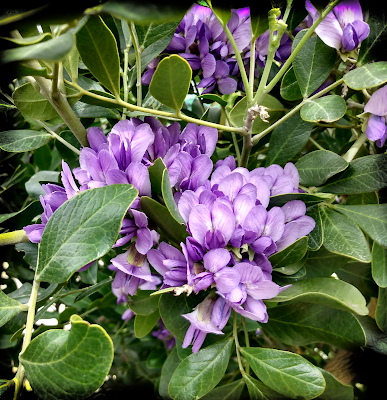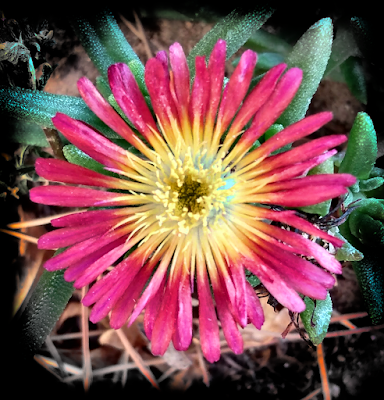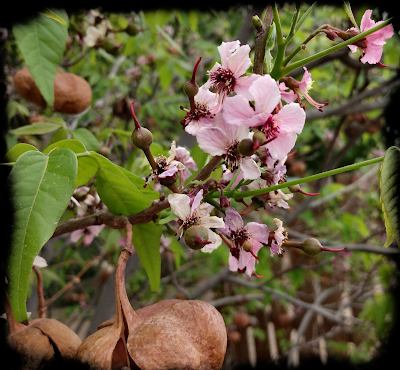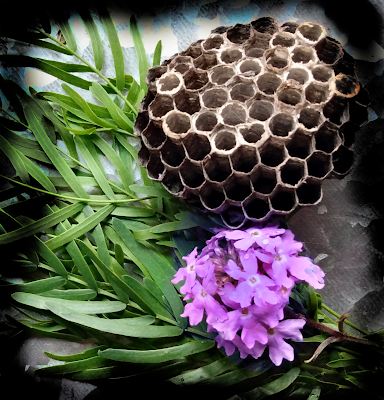Lavender's green.
When I am king, dilly dilly
You shall be queen."
Once upon a time I had an ample supply of blooming lavender, and a wonderful co-worker showed me how to make lavender wands. This was, oh, perhaps 40 years ago now?
Alas and alack, I have a very limited supply of blooms this year. Between three small two-year-old bushes, I had enough blooms for three wands.
It's easy to make them, and it's a bit of lore I'd love to pass on.
All it takes is the fresh lavender cut with as long a stem as you can manage (it can have little leaves and side-buds on it); 1/8" satin ribbon or similar narrow ribbon of your choice for a small wand, and wider ribbon if you are lucky enough to make a big wand; and a toothpick to help you move the ribbon among the stems evenly.
Skip down to read about how to make wands!
But first, some garden news! (1) The Egyptian Walking Onions at the community garden are making "pups" and I have planted some at home. WILL THEY MAKE IT? (2) The lemongrass in my courtyard seems a lost cause. It is not visible any longer! The doggies have eaten it all. I always call one of my dogs "my little curly lamb," and indeed she is like a sheep, chewing grass. The chiweenie was in on it, too. They split up the lemongrass between them: He ate all of it at ground level, and she climbed into the raised beds and ate the rest! (3) The Sweet Meat squash is up and looks like it might make it.
Back to our wands:
Gently remove any side leaves or side-buds. Work with fresh lavender. The type doesn't matter. If needed, put the cut lavender in water in a vase in the fridge, like the florist does.
I could not put my hands on my plastic canvas sewing "needle," made of plastic with a huge eye for yarn. But that might make the weaving so very much easier.
There are many tutorials on the web on how to make these wands, but many of them are bunk. Why do I say that? They don't share the most basic part of making the wands: YOU MUST HAVE AN ODD NUMBER OF STEMS. The simple over-under weave will not work with an even number of stems. You are going in a spiral pattern, a basketweave, and thus an odd number is a must.
But the other tutorials have nicer photos. I was doing this, oh, around 3:12 a.m. I had intended to do it in the morning, but I had already picked the stems and taken a photo of them with the ribbon,then put them in the fridge. Since I have terrible trouble sleeping more than an hour at a time without having to get up, it seemed like a good idea to get up and make wands at that hour, but it didn't lend itself to clear thinking or clear photos.
Gather as many stems as you want together, with the HEADS of the lavender together. Make sure to have an odd number. Tie a piece of ribbon right under the heads. Don't make the knot too tight. Don't cut into the stems.
I just use one piece of ribbon, so I make sure the knot has a tail that extends down several inches. I'm going to tuck that tail in the middle and let it just hang, and let it be covered by the weaving of the other end of the ribbon, and then once I am done weaving and wrapping the unwoven stems about a half-inch to an inch, I use that bit of tail between the stems to tie off the weaving ribbon, and cut the excess from both tails.
The other way is to just make a nice knot and cut, then tuck in the end of another piece from the ends of the stems and coming out from the top of the "cage" described below.
Making the cage: Once you have the knot in place under the heads of the lavender, you carefully pull up each stem to make a "cage" around the heads. At this point, just pull them gently, one at a time, up and over the flowerheads. You will use the toothpick or your fingers to arrange the stems as evenly as you can. Now turn it over. You are holding the stems and the caged flower heads are at the top.
Some people with a LOT of lavender make wands that are practically CLUBS. I envy them! If you want to make a huge one, limit your weaving to just the outer stems.
To figure out how much ribbon you will need to cut to do the weaving, I put my fingers together, like two fingers for a small wand (I have tiny fingers), and wrap the ribbon round and round in a downward spiral until it's as long as the caged flower heads. Then I add about two inches. CUT.
If you are using the one-ribbon method, the other end is still inside the cage, part of the knot that is under the flower heads. Come up under a stem, pull the excess ribbon through, and go over the next stem. Then under the next, over the next, under the next, again and again until you have covered the entire head. Don't overthink it.
This is the part that is difficult. The first few turns are hard to do, and the basketweave isn't very visible yet. You are working from the TOP down.
Use your toothpick to push up and tighten the ribbon as needed. It might be like lacing up a shoe. You pull up some excess, and kind of sequentially pull the slack up between each stem, all the way down. Then wrap the stems without doing any over-and-under once you are past the "caged" part. Pull out that tail and tie an overhand knot with the weaving end of the ribbon.
Make sure the weaving is pretty tight, because the flowers will shrink as they dry. My darker wands came out much better than the first pale ribbon one I did. The blue ribbon above needs to be pulled and the slack taken out before continuing.
To refresh the scent, just squeeze gently on the woven end of the wand.
I hope everyone had a good weekend and is having a good Monday!














































